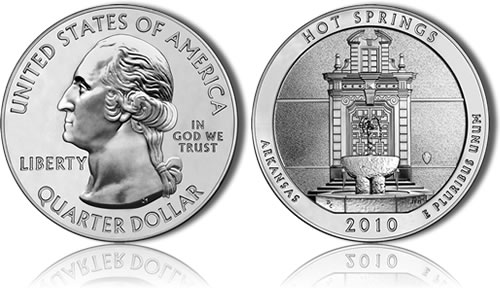The Hot Springs National Park Silver Uncirculated Coin was the first of the United States Mint collectible coins to weigh five ounces with a three-inch diameter.

Released as a companion to the Hot Springs National Park Silver Bullion coin within the America the Beautiful Silver Bullion Coins Program, it honors Hot Springs National Park located in the state of Arkansas.
Unlike the bullion version which was released on December 10, 2010, and sold through the US Mint network of authorized dealers, the uncirculated coin was sold directly by the US Mint to any interested buyer. However, while it was produced in 2010, the uncirculated coin was actually not released until April 28, 2011.
Demand for the debut strike of the series was intense leading to ordering difficulties for many within the first few hours of availability. In fact, the Mint’s online ordering system even encountered issues as collectors clamored to obtain the strikes. Within two weeks, the Mint’s entire mintage of 27,000 of the Hot Springs Silver Uncirculated Coins had been ordered – each at a price point of $279.95.
The uncirculated coin design shares the same design as the bullion version and the circulating America the Beautiful Quarter. The obverse or heads side has the recognized portrait of President George Washington by John Flanagan along with Inscriptions of UNITED STATES OF AMERICA, LIBERTY, IN GOD WE TRUST and QUARTER DOLLAR.
The reverse or tails side, Don Everhart and sculpted by Joseph Menna, shows an image of the park’s headquarters building in the background and a fountain in the foreground. Inscriptions include HOT SPRINGS, ARKANSAS, 2010 and E PLURIBUS UNUM.
Hot Springs National Park in Arkansas
Hot Springs National Park in Arkansas was the destination of the Dunbar-Hunter Expedition sent by President Thomas Jefferson in 1804. While not the first National Park — Yellowstone is — it is American’s oldest declared national site, made so on April 20, 1832. Congress gave it national status to preserve the 47 springs that emerge from Hot Springs Mountain and to ensure that the water was made available for drinking and therapy. The site officially became a national park in 1921. It has an area of 5,400 acres, and is under federal jurisdiction of the National Park Service.
